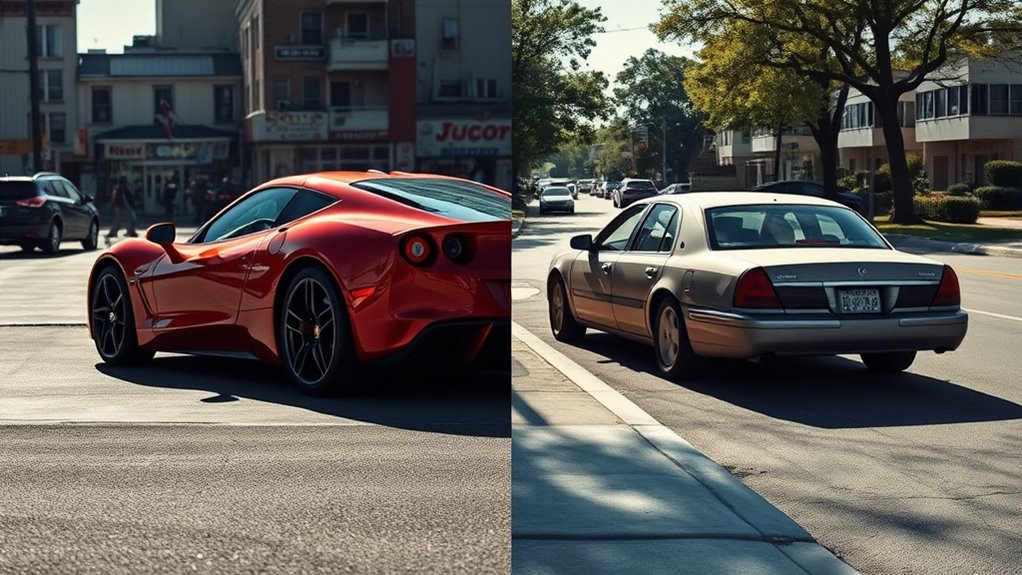Steering through the world of auto insurance can feel like walking a tightrope, where the balance between risk and cost is vital. When you compare high-risk and standard auto insurance, you'll notice striking differences in premiums and coverage options. Understanding these distinctions is imperative, especially if your driving history isn't spotless. What factors truly influence these rates, and how can they impact your decision-making? The answers might surprise you.
When comparing auto insurance, how do you determine which coverage best suits your needs? You'll want to understand the two main categories: high-risk and standard coverage. High-risk insurance is designed for drivers deemed higher risks by insurance providers, typically due to factors like at-fault accidents or severe traffic violations, such as DUIs. If you find yourself classified as a high-risk driver, expect to pay more for your premiums compared to standard drivers. In Ohio, drivers who require SR-22 insurance may face additional challenges in securing affordable coverage.
Understanding the difference between high-risk and standard auto insurance is crucial for finding the right coverage for your needs.
Insurance companies often respond to high-risk classifications by offering nonstandard policies, which may come with higher deductibles and limited coverage options. Some states provide high-risk pools for drivers who can't secure coverage through traditional insurers, creating an avenue for those in need. However, if you're a high-risk driver, it's important to recognize that your options might be more limited and costly.
When evaluating insurance rates, several factors come into play. Your vehicle's characteristics, including its make, model, age, and security features, greatly impact your insurance costs. Location also plays a significant role; for instance, urban areas typically have higher rates compared to rural ones. Additionally, annual mileage can significantly influence your premiums, as more driving generally leads to higher costs.
Your driving record is perhaps the most important determinant—accidents and violations can lead to substantial rate increases. Additionally, the amount you drive annually can affect premiums; more driving generally leads to higher costs. Finally, insurers often use credit scores to gauge risk, with better scores typically resulting in cheaper premiums.
If you're in the market for high-risk insurance, be prepared for the associated expenses. It's common for high-risk policies to cost substantially more due to the perceived risk of claims. You might encounter policies with higher deductibles or limited coverage options, making it important to evaluate what you truly need.
Companies like GEICO and State Farm offer varying rates for high-risk drivers, and some specialize in covering those with poor driving records, giving you a range of options to explore.
Common factors that label drivers as high-risk include at-fault accidents, which can raise premiums by 30-60%. Serious infractions, such as DUIs, result in substantial rate hikes, and drivers with multiple tickets or claims histories are often categorized as high-risk. Additionally, limited or no prior insurance coverage can signal a higher risk, as does being a younger or inexperienced driver.
On the other hand, standard auto insurance typically encompasses liability, collision, and extensive coverage options. Premiums for these policies depend on factors like your driving record and vehicle type. Standard policies often come with discounts for good grades, safe driving, or bundling multiple policies. Adjusting deductibles and coverage limits can also influence your costs.
Ultimately, managing your insurance costs requires diligence. Utilize available discounts, consider raising deductibles, and maintain a clean driving record. Comparing quotes from various insurers can help you find the best deal, especially if you're maneuvering through the complexities of high-risk or standard auto insurance.
Conclusion
In the landscape of auto insurance, maneuvering the winding roads of high-risk and standard options is essential. High-risk insurance, with its steep premiums and narrow coverage, contrasts sharply with the open highways offered by standard policies, where drivers with clean records enjoy more favorable rates and broader protections. By understanding these differences, you can steer your choices wisely, ensuring you find the right coverage that suits your driving profile and financial needs—like choosing the right vehicle for your journey ahead.

